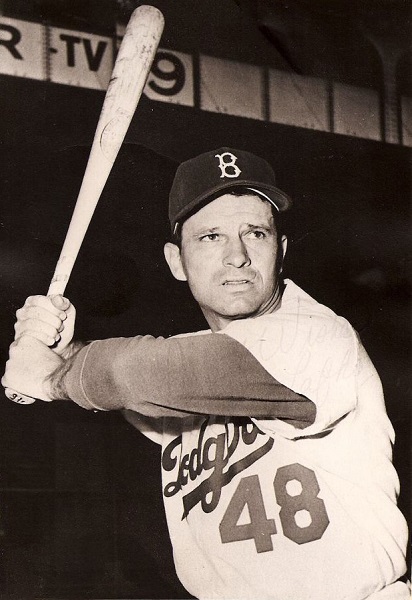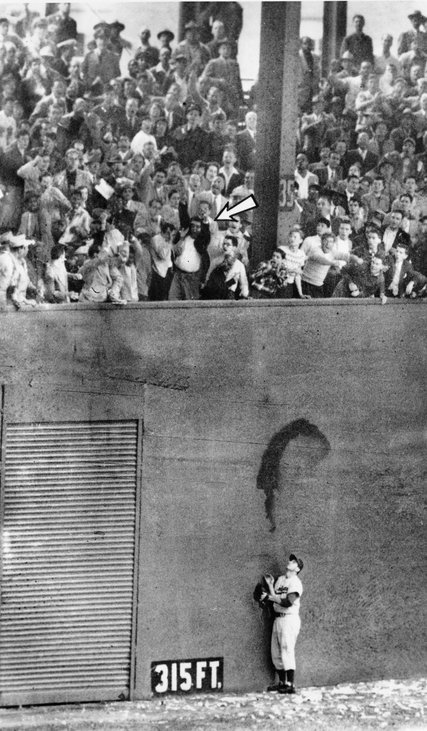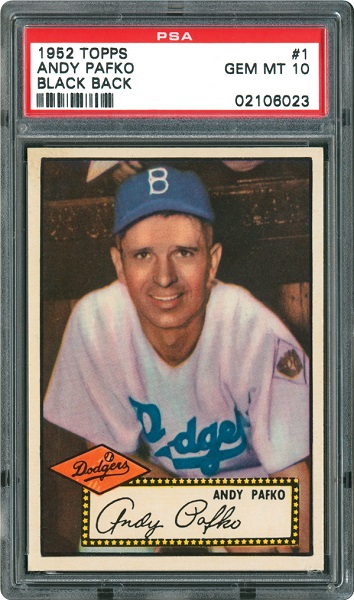I trace my birth as a Dodger fan back to the 1952 season. Vin Scully and Duke Snider were the midwives in bringing me into the world of “Dodger Blue.” Vin’s voice captivated me one evening in 1952 when I turned the dial on my radio and accidentally came across a Dodgers broadcast. It was my first-ever baseball radio broadcast. I loved baseball as an 11-year-old and instantly was glued to the broadcast and that voice. I had listened to hockey games on radio prior to the most important baseball broadcast in my life but never had heard a voice like that, nor do I recall who the hockey commentators were.
Duke Snider hit the first home run in my inaugural baseball listening experience and who wouldn’t love a name like “Duke” and a home run. I instantly imprinted on Duke.
I have no actual record of the game in 1952 or even a way to confirm it was 1952 except for two events, one of which is notorious for all remaining Brooklyn Dodger fans. That was Bobby Thompson’s Shot Heard ‘Round the World in 1951. As a youngster I was not part of the listening audience on that dark day in Dodgers history and only learned of it at a later point along my baseball road. From that I concluded my first Dodgers season was not 1951.
The second marker for me was that my first Dodgers outfield had Duke Snider in center field flanked by Carl Furillo in right field and Andy Pafko in left field. Pafko had been traded to the Dodgers from the Cubs during the 1951 season but then played a full season with the Dodgers in 1952. Pafko was traded to the Milwaukee Braves by the Dodgers after the 1952 season, so 1953 could not have been my Dodgers birthing year. Andy Pafko is the key to my whole timing thing.

Pafko hit .274 with 37 home runs in his two seasons with the Brooklyn Dodgers. (AP photo)
Pafko’s career is perhaps one that is as interesting as that of any player who has ever played the game. It is not dotted with leading career statistics or records that may never be broken but is punctuated with a number of baseball oddities that make Andy Pafko one of the true characters of the game.
Known for his work ethic and his unusual crouching batting stance, the right-handed hitting outfielder made his debut with the Chicago Cubs on September 24, 1943, earning a promotion after winning the Pacific Coast League batting title and being chosen as the league MVP.
He led the Cubs to the World Series two seasons later in 1945 by batting .298 with 12 home runs and a career-high 110 RBIs, finishing fourth in the National League most valuable player balloting. Pafko played on the last Chicago Cubs team to represent the National League in the World Series. The Cubs fell to the Detroit Tigers in seven games and Cubs fans are still waiting for another World Series appearance by their beloved Cubbies.
In 1949 Pafko was involved in one of the most unusual plays to ever have happened in MLB. He was the victim of the only “inside the glove home run” in MLB history. Known throughout his career for his all-out effort and diving catches, he caught a blooper off the bat of St. Louis first baseman Rocky Nelson, or so he thought. Umpire Al Barlick called it a trapped ball, perhaps confused by the paper cups on the field. Pafko held the ball in the air arguing he had caught it but neglected to ask for a time out. Nelson and a lead runner continued running and scored giving the Cardinals a 4-3 victory. That same Rocky Nelson was to become Pafko’s teammate with the Dodgers in 1952. Nelson played 37 games with the Dodgers backing up first baseman Gil Hodges.
Andy Pafko did not like to strike out. In 1950 the five time all-star struck out only 32 times while hitting 36 home runs. He became one of very few players with a minimum of 20 home runs to have more home runs than strikeouts in a single season. He also walked 69 times. Hall of Fame Yankees catcher Yogi Berra is the leader in that department having accomplished the feat five times.
On June 15, 1951 the Cubs sent Andy Pafko, Wayne Terwilliger, Rube Walker and Johnny Schmitz to the Dodgers for Gene Hermanski, Eddie Miksis, Joe Hatten and Bruce Edwards. Pafko was the primary target by the Dodgers and was acquired to shore up their left field position in preparation for a World Series run. However, his season was not to end as anticipated by him or the Dodgers. On October 3 during the final game of the playoffs with the New York Giants, Pafko had a close up view of the aforementioned Bobby Thompson home run as it crossed over his head and the left field fence, thereby denying his and the Dodgers trip to the Fall Classic.
“[Ralph] Branca walked by me in left field. I hit him in the back. ‘Go get ’em, Ralph,'” Pafko recalled later. “But I was doubting. Branca threw a ball. Then came this shot. I started back. In Ebbets Field I might have gotten it. In the Polo Grounds it was gone. The moment was my biggest letdown ever.” (Note: The left field fence at the Polo Grounds was only 315 feet from home plate).

“In Ebbets Field I might have gotten it.” – Andy Pafko
(AP photo)
Then in 1952 something off the field and unusual happened to Andy Pafko. Topps issued its signature baseball card set. It is truly the card set of all sets. There were many baseball heroes of the day that could have been featured as the first card in that set but Topps chose Andy Pafko as #1 in its landmark debut set. Sy Berger, then a 28-year-old veteran of World War II, designed the 1952 Topps baseball card set with Woody Gelman on the kitchen table of his apartment on Alabama Avenue in Brooklyn.

Andy Pafko’s mint 1952 Topps baseball card.
Although the reason for his number one status is not clear, other than a Brooklyn connection, Pafko’s card maxed out at much more than those of many other more high profile stars.
“Nearly 40 years after his last major league season, Pafko was astounded to learn that one of his 1952 Topps trading cards had sold for $83,870 at an auction in Washington,” wrote Richard Goldstein in a New York Times article. “The card, found by a collector in an unopened pack for which he paid $1,000, according to Sports Collectors Digest, was in mint condition.”
Pafko lamented with a laugh that he had received boxes of cards from Topps in the 1950s but never kept any.
“I just gave the cards to the kids in the neighborhood and they put them in their bicycle spokes,” he told The Associated Press. “And there went the money — click, click, click.”
The 1952 season was to be Pafko’s last with the Dodgers and it was a good one on all counts. During that season he played 150 games in a 154-game schedule. Duke Snider played 144 and Carl Furillo 134. Pafko played primarily in left field but also appeared in center field, right field and at third base.
That had to be a dream outfield. Duke Snider climbing the wall to bring down long flies, Carl Furillo playing the right field wall at Ebbets Field like a chess master and Andy Pafko diving for anything remotely close to him. During the 1952 season Snider had 13 outfield assists, Furillo had 12 and Pafko had 18.
Pafko’s 1952 season with the Dodgers was also a very productive one offensively in which he hit .287 with 19 home runs along with 87 RBI. He had an OBP of .366 and and OPS of .803. All of those stats ranked around twelfth best in the National League.
His first two seasons with the Braves in 1953 and 1954 were comparable to his last season with the Dodgers, although he played right field. However, during his last five years with the Braves he was relegated to part time duty, having been replaced in right field by a young upstart named Hank Aaron.
In yet another twist in the wonderful, unpredictable world of baseball, Bobby Thompson was traded by the Giants to the Milwaukee Braves in 1954 making him teammates with Andy Pafko for four years. As might also be predicted, they roomed together on the road.
“I had to ask him how he felt personally when he hit the home run,” Pafko once told The Journal-Sentinel of Milwaukee. “But he was such a modest guy, he didn’t want to talk about it.”
Another interesting Pafko anecdote was related to DCN Sports Editor Joel Becker in 2004 in which he claims to have hit the longest ever home run.
“We were playing the Boston Braves [on the road], who became the Milwaukee Braves. … I hit a home run over the left field wall. And at the precise time I hit it — there was a railroad tracks — an empty, slow freight train was coming by, pulling empty coal cars. And that ball landed in a coal car and went from Boston to New York — 320 miles.”
Andy Pafko was born in Boyceville, Wisconsin so it was only befitting that he would finish his career with the Milwaukee Braves. It may also have been the reason he was traded by the Dodgers. That is, to give the newly minted Milwaukee Braves a homegrown star. He retired after the 1959 season with a career batting average of .285 and 213 home runs.
“Handy Andy” – as he was known because of his versatility – died on October 8, 2013 at the age of 92.




 December 28th, 2015 at 6:00 am
December 28th, 2015 at 6:00 am  by Harold Uhlman
by Harold Uhlman  Posted in
Posted in 

Although Pafko did not play for the Dodgers very long, I still consider the outfield of Pafko, Snider and Furillo as the Dodgers’ best.
I agree OBF.
Great stuff, Harold. Thanks!
Chicagoans call it the Cubs factor. In a post-season series, the team with the most former Cubs will lose. Great story.